15 Days Lower Body Challenge! 13+ Cable Leg Exercises For Stallone-Style Leg Muscles
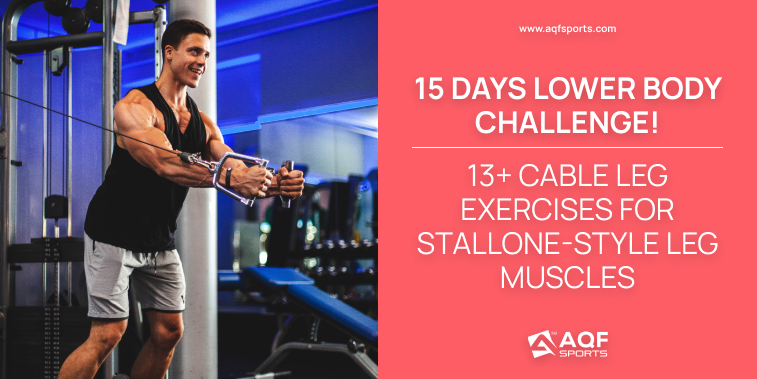
Here at AQF Sports, we swear by deadlifts and squats to build lower body strength. These two trainings activate every inch of muscles in your lower body while stabilizing your spine. But these two exercises might not be enough if your strength training goal is to achieve maximum athletic performance and tone leg muscles. You might need to throw in cable leg exercises in your workout routine.
It’s no surprise that most of us focus more on upper body strength rather than lower body. Skipping leg day leads to a disproportionate body mass distribution in upper and lower body. You don’t wanna end up looking like a ripped up Johnny Bravo with ghastly nimble legs – You want to look like Sylvester Stallone.
We get it. The following cable leg exercises can be added to your regular workout routine or done as a standalone 15 days lower body workout challenge to tone and sculpt your lower extremities. But in order to do that, you must:
- Be consistent
- Progressively overload your training
Only then you can achieve optimal strength and endurance while sculpting your legs.
Who Should Sign Up for This Lower Body Cable Exercises Challenge?
Now, you might be wondering how the lower body cable exercises challenge is better than your traditional machine workouts?
Here are a few things you can expect from this workout challenge:
Leg Muscle Activation:
Cable squats, lunges, and deadlifts activate the quadriceps, glutes, hamstrings, and calves more effectively than traditional free weight exercises. [1]
You can specifically target these muscle groups and maximize their activation for increased strength by following this lower body leg challenge.
Leg Muscle Growth:
Cable exercises increase workout resistance. Studies report that cable exercises activate lower extremities muscles. As a result, blood flow to lower meg muscle fibers increases and they grow in size.[2]
If you stick to this challenge for 15 days or more, you can stimulate muscle growth in your quadriceps, glutes, hamstrings, and calves – ultimately, defining and sculpting legs.
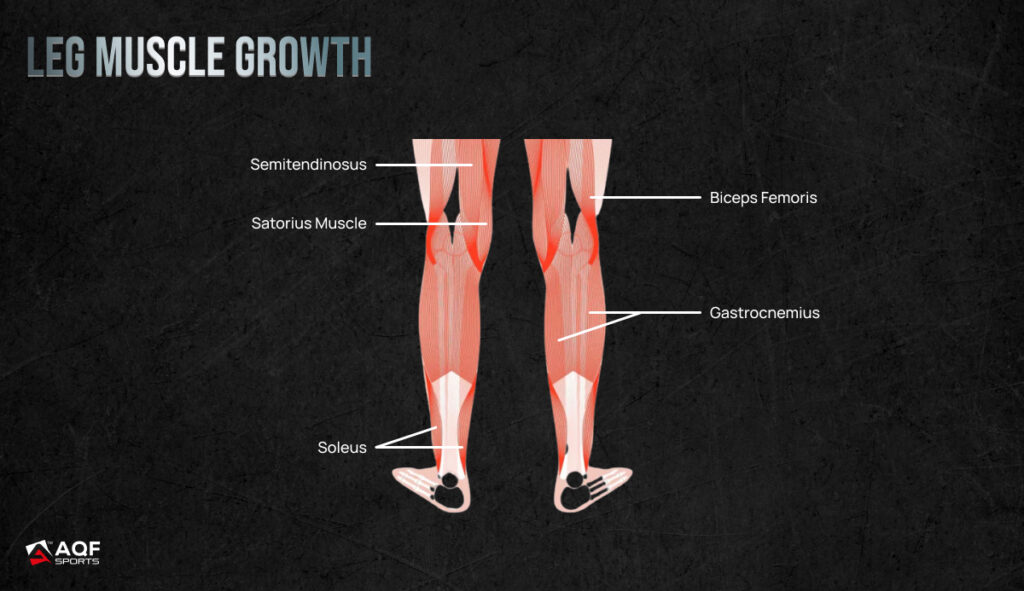
Body Stability and Balance:
Cable exercises, like cable standing hip abductions, adductions, and single-leg movements require body stability and balance. Research shows that cable leg exercises improve lower body balance and control. [3]
By the end of this challenge, you will stand or move more confidently, athletically and fluidly.
Tone Leg Muscles:
Our well-rounded leg workout challenge includes cable exercises which define muscles. Following cable leg exercises in conjunction with proper diet will reduce body fat, increase muscle mass and sculpt your leg muscles. [3]
At the end of this challenge, your legs will look more defined and athletic and you will feel more confident.
Functional Strength:
Cable exercises increase leg strength which activates functional movements and athletic performance. Stronger quadriceps, glutes, hamstrings, and calves improve body strength, stability, and agility. [4]
When you complete this challenge, you will easily beat others in sports and other physical activities.
So, if you want to Achieve:
- Sculpted Legs like iconic bodybuilders (Picture Arnold Schwarzenegger)
- Lower body strength and endurance (One that breaks toughest materials)
- Athletic build, agility and body balance (to beat your sports rivals)
We have an exciting 15 days lower body challenge for you. By the end of this challenge, you will feel more energetic, confident and agile while doing other exercises and even during daily tasks like walking, running or sports.
So, Do you dare?
The Ultimate 15 Days Lower Body Cable Exercises Challenge!
Let’s get to the point – our comprehensive 15 days lower body training challenge is perfect for lower body strength building.
Day 1: Getting Started
Total Estimated Time: 25-40 minutes
| Exercise | Reps | Sets | Muscles Activated |
| Cable Squats | 10-12 | 3 | Quadriceps, Glutes, Hamstrings, Calves |
| Cable Standing Hip Abductions | 12-15 per leg | 3 | Hip Abductors, Glutes |
| Cable Calf Raises | 12-15 | 3 | Calves |
Day 2: Glute Activation
Estimated Time: 30-45 minutes
| Exercise | Reps | Sets | Muscles Activated |
| Cable Goblet Squats | 10-12 | 3 | Quadriceps, Glutes, Hamstrings, Calves |
| Cable Romanian Deadlifts | 10-12 | 3 | Hamstrings, Glutes, Lower Back |
| Cable Glute Kickbacks | 12-15 per leg | 3 | Glutes, Hamstrings |
Also Read: 5-Minute Full Body Cool Down Exercises
Day 3: Rest and Recovery
Day 4: Leg Sculpting
Total Estimated Time: 30-45 minutes
| Exercise | Reps | Sets | Muscles Activated |
| Cable Lunges | 10-12 per leg | 3 | Quadriceps, Glutes, Hamstrings, Calves |
| Cable Standing Leg Curl | 10-12 per leg | 3 | Hamstrings |
| Cable Standing Hip Adductions | 12-15 per leg | 3 | Hip Adductors, Glutes |
Day 5: Lower Body Power
Total Estimated Time: 25-40 minutes
| Exercise | Reps | Sets | Muscles Activated |
| Cable Sumo Squats | 10-12 | 3 | Quadriceps, Glutes, Hamstrings, Calves |
| Cable Split Squats | 10-12 per leg | 3 | Quadriceps, Glutes, Hamstrings, Calves |
| Cable Calf Raises | 12-15 | 3 | Calves |
Day 6: Balance and Stability
Total Estimated Time: 30-45 minutes
| Exercise | Reps | Sets | Muscles Activated |
| Cable Single-Leg Romanian Deadlifts | 10-12 per leg | 3 | Hamstrings, Glutes |
| Cable Prone Leg Curl | 10-12 | 3 | Hamstrings |
| Cable Standing Hip Abductions | 12-15 per leg | 3 | Hip Abductors, Glutes |
Day 7: Rest and Recovery
Day 8: Leg Strength
Total Estimated Time: 30-45 minutes
| Exercise | Reps | Sets | Muscles Activated |
| Cable Bulgarian Split Squats | 10-12 per leg | 3 | Quadriceps, Glutes, Hamstrings, Calves |
| Cable Deadlifts | 10-12 | 3 | Hamstrings, Glutes, Lower Back |
| Cable Calf Raises | 12-15 | 3 | Calves |
Day 9: Hamstrings
Total Estimated Time: 30-45 minutes
| Exercise | Reps | Sets | Muscles Activated |
| Cable Lunges | 10-12 per leg | 3 | Quadriceps, Glutes, Hamstrings, Calves |
| Cable Standing Leg Curl | 10-12 per leg | 3 | Hamstrings |
| Cable Glute Kickbacks | 12-15 per leg | 3 | Glutes, Hamstrings |
Day 10: Rest and Recovery
Day 11: Leg Endurance
Total Estimated Time: 25-40 minutes
| Exercise | Reps | Sets | Muscles Activated |
| Cable Squats | 10-12 | 3 | Quadriceps, Glutes, Hamstrings, Calves |
| Cable Standing Hip Abductions | 12-15 per leg | 3 | Hip Abductors, Glutes |
| Cable Calf Raises | 12-15 | 3 | Calves |
Day 12: Full Lower Body Burn
Total Estimated Time: 30-45 minutes
| Exercise | Reps | Sets | Muscles Activated |
| Cable Goblet Squats | 10-12 | 3 | Quadriceps, Glutes, Hamstrings, Calves |
| Cable Deadlifts | 10-12 | 3 | Hamstrings, Glutes, Lower Back |
| Cable Glute Kickbacks | 12-15 per leg | 3 | Glutes, Hamstrings |
Day 13: Rest and Recovery
Day 14: Quads
Total Estimated Time: 30-45 minutes
| Exercise | Reps | Sets | Muscles Activated |
| Cable Sumo Squats | 10-12 | 3 | Quadriceps, Glutes, Hamstrings, Calves |
| Cable Split Squats | 10-12 per leg | 3 | Quadriceps, Glutes, Hamstrings, Calves |
| Cable Calf Raises | 12-15 | 3 | Calves |
Day 15: Total Leg Workout
Total Estimated Time: 30-45 minutes
| Exercise | Reps | Sets | Muscles Activated |
| Cable Single-Leg Romanian Deadlifts | 10-12 per leg | 3 | Hamstrings, Glutes |
| Cable Prone Leg Curl | 10-12 | 3 | Hamstrings |
| Cable Standing Hip Adductions | 12-15 per leg | 3 | Hip Adductors, Glutes |
Now, let’s move on to how to perform exercises mentioned above.
Beginner Cable Machine Exercises
Cable Squats:
- Face away from the cable machine, Stand on your feet shoulder-width apart
- Get close to the cable machine handle and hold it with both hands
- Bend your knees and lower your hips down into a squat position
- Keep your chest up, back straight, and put all your weight on your heels.
- Push back up through your heels and return to the starting position. Repeat.
Primary muscles: Quadriceps
Secondary muscles: Glutes, Hamstrings, Calves
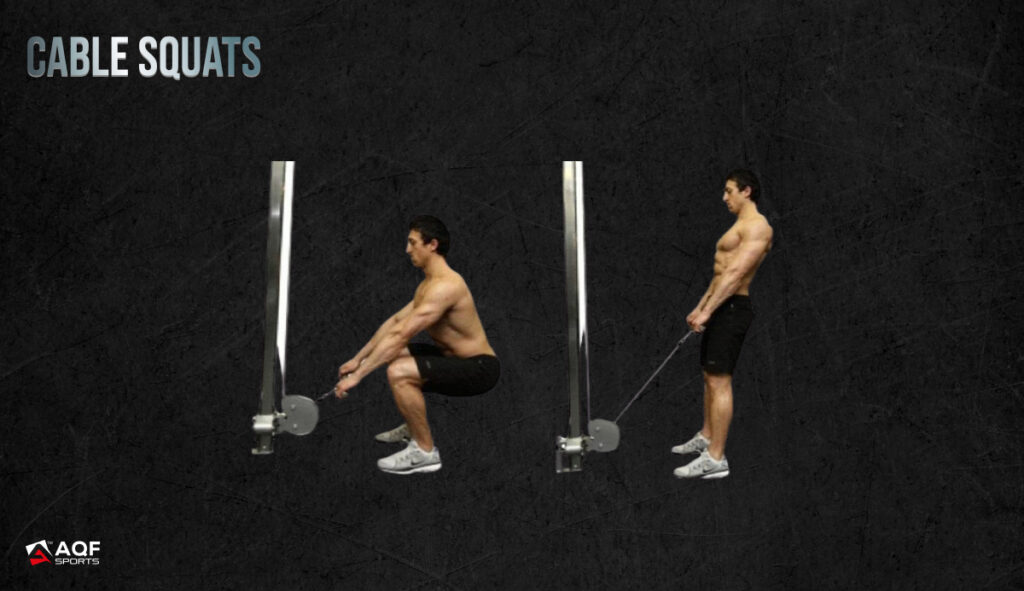
Cable Lunges:
- Attach one end of ankle straps to the cable machine and the other with your ankles
- Hold the cable machine handles to maintain body balance as you extend your feet
- Extend the cable with your leg and step one foot backward into a lunge position
- Lower knee toward the floor and keep your front knee bent a 90-degree angle.
- Push up from your front heel to return to the starting position.
- Repeat with other leg
Primary muscles: Quadriceps
Secondary muscles: Glutes, Hamstrings, Calves

Cable Standing Hip Abductions:
- Secure the ankle strap around your ankles
- Attach the free end of ankle strap to the cable machine and stand sideways
- While standing, lift the leg out to the side against the resistance and hold.
- Slowly bring your leg back to the starting position.
Primary muscles: Glutes (Gluteus Medius)
Secondary muscles: Quadriceps, Calves
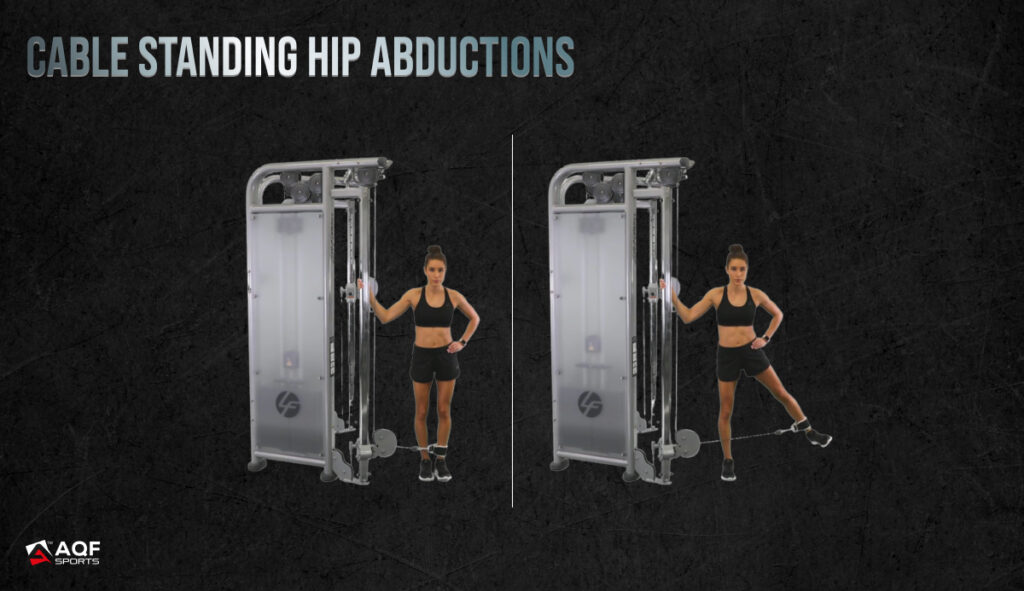
Cable Calf Raises:
- Stand on your feet Face cable machine
- Hold the cable machine handles for balance
- Place your heels on the edge of the cable machine step
- Raise your heels as high as possible and extend your knees
- Hold for a moment at the top, and then lower your legs down.
Primary muscles: Calves (Gastrocnemius, Soleus)
Secondary muscles: Quadriceps, Hamstrings

Intermediate Cable Machine Exercises
Cable Goblet Squats:
- Set the cable pulley at a low position. Stand on your feet, face away from the machine.
- Hold the cable with both hands and bring your chest closer to the machine
- Bend your knees and Lower your hips into a squat position.
- Keep your chest up, back straight, and put all body weight on your heels.
- Push into the ground through your heels and return to the starting position.
- Repeat with other leg
Primary muscles: Quadriceps
Secondary muscles: Glutes, Hamstrings, Calves

Cable Romanian Deadlifts:
- Set the cable pulley at a low position and stand facing the machine.
- Hold the cable handle with both hands in front of your thighs
- Bend forward at the hips and keep your knees slightly bent.
- Lower the cable handle toward the floor and stretch your hamstrings.
- Squeeze your glutes and move your hips forward as you stand up
Primary muscles: Hamstrings
Secondary muscles: Glutes, Lower Back, Calves
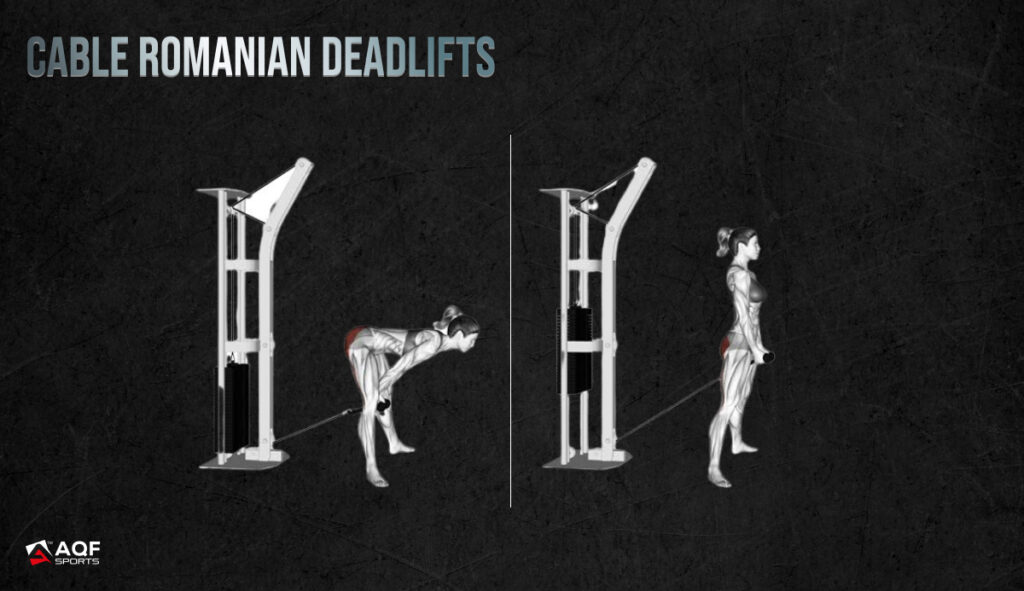
Cable Glute Kickbacks:
- Attach an ankle strap to the cable machine and face the machine
- Keep your hands on the frame for support.
- Secure the ankle strap around your ankle.
- Kick one leg backward, keep it straight and squeeze your glutes.
- Return to the starting position and repeat with the other leg.
Primary muscles: Glutes (Gluteus Maximus)
Secondary muscles: Hamstrings, Calves
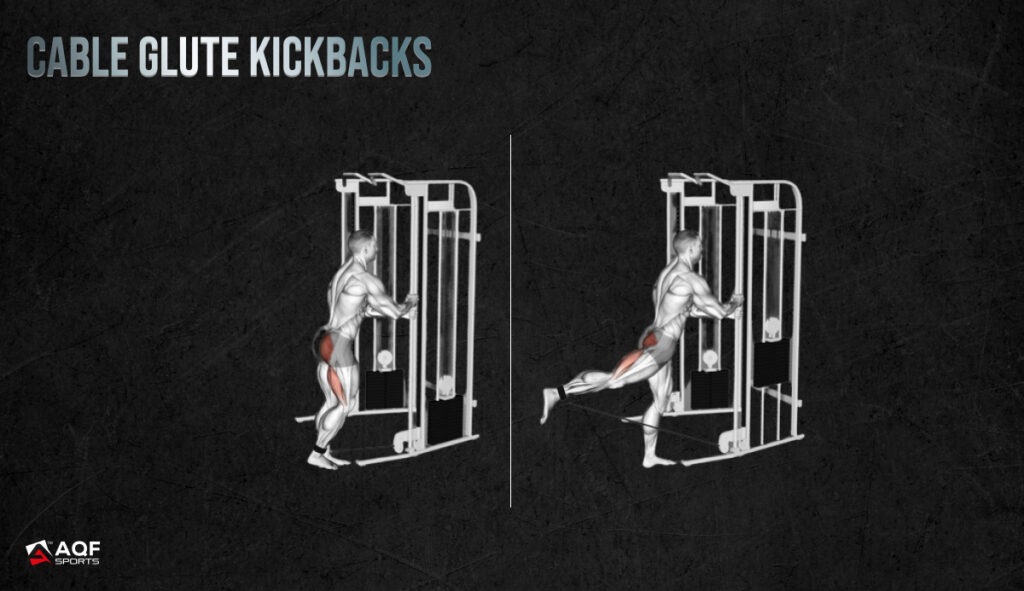
Cable Standing Leg Curl:
- Attach an ankle strap to the cable machine and stand facing the machine.
- Secure the ankle strap around your ankle.
- Stand straight, bend your knee, and curl your heel toward your glutes against the resistance.
- Slowly extend your leg back to the starting position.
Primary muscles: Hamstrings
Secondary muscles: Glutes, Calves
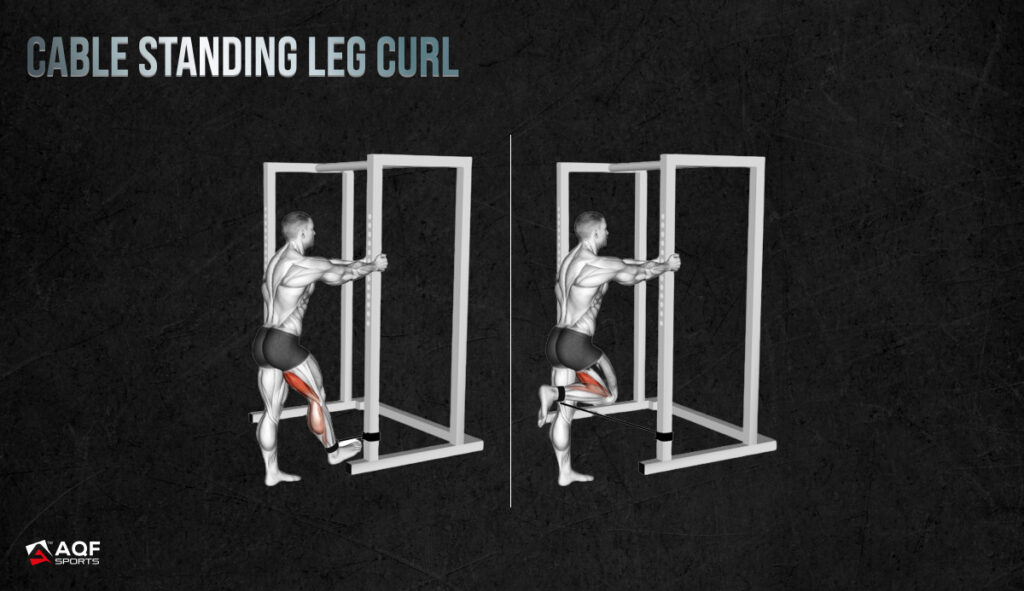
Cable Prone Leg Curl:
- Attach an ankle strap to the cable machine and lie face down on a bench or mat.
- Secure the other end of ankle strap around your ankle.
- Bend your knee and curl your heel toward your glutes against the resistance.
- Slowly extend your leg back to the starting position.
Primary muscles: Hamstrings
Secondary muscles: Glutes, Calves
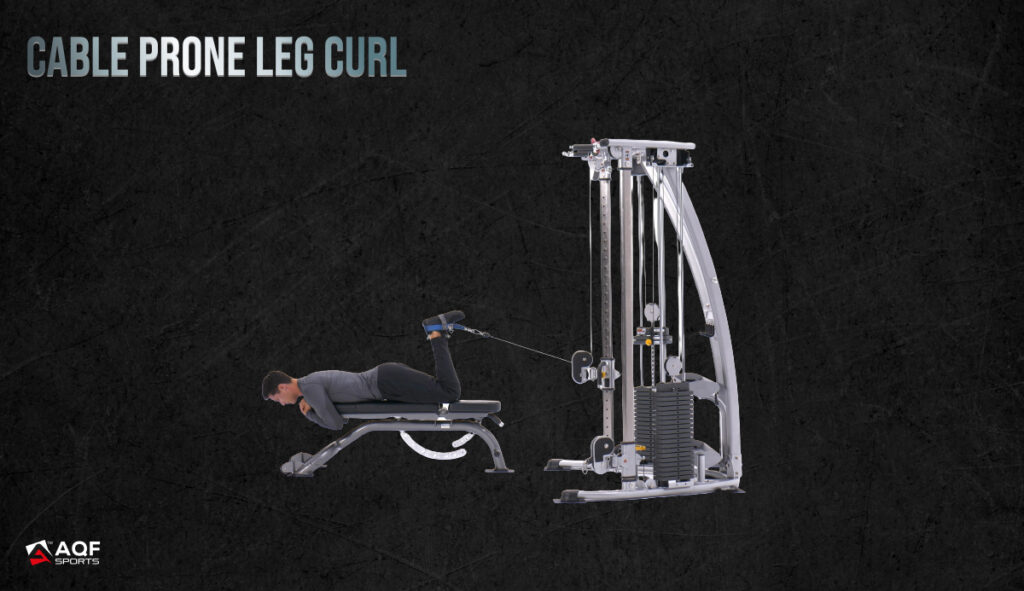
Advanced Cable Machine Exercises
Cable Sumo Squats:
- Set the cable pulley at a low position and stand on your feet facing the machine
- Place your feet wider than shoulder-width and turn your toes out
- Bring your chest close to the cable machine and hold with both hands
- Bend your knees and lower your hips into a squat position by bending your knees
- Bring your knees at your toe level
- Keep your chest up, back straight, and put all the weight on your heels.
- Push into the ground through your heels and return to the starting position.
Primary muscles: Quadriceps, Glutes
Secondary muscles: Hamstrings, Calves

Cable Bulgarian Split Squats:
- Set the cable pulley at a low position and stand facing away from the machine.
- Position one foot forward and the other foot elevated behind you on a bench or platform.
- Hold the cable handles for balance.
- Lower your body by bending your front knee, keeping your back knee close to the floor.
- Push through your front heel to return to the starting position.
- Complete the desired number of repetitions, then switch legs.
Primary muscles: Quadriceps, Glutes
Secondary muscles: Hamstrings, Calves
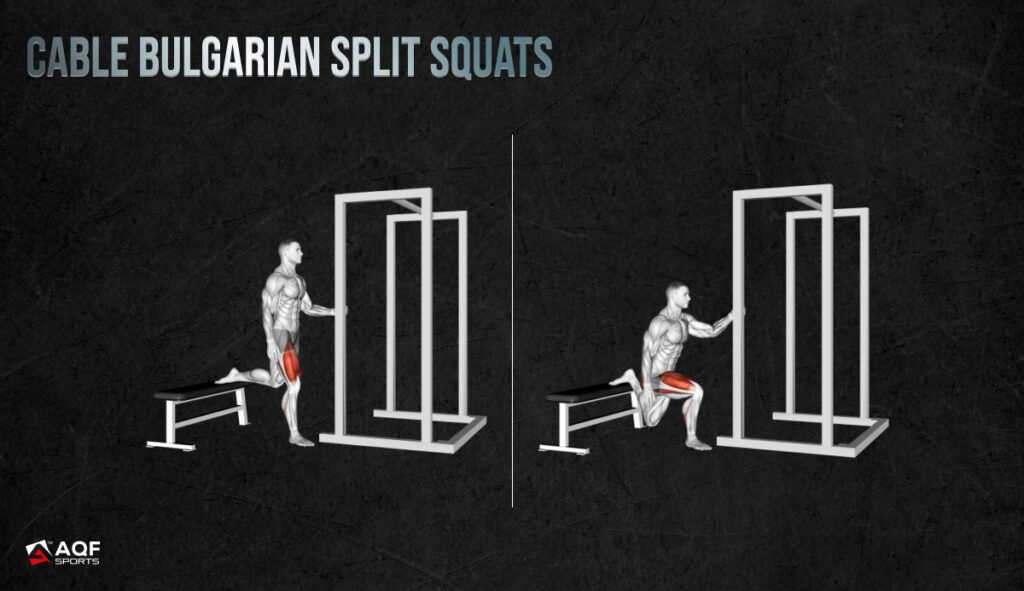
Cable Single-Leg Romanian Deadlifts:
- Set the cable pulley at a low position and stand facing the machine.
- Hold the cable handle in one hand and balance on the opposite leg.
- Slightly bend at your standing leg and flex forward at the hips
- Lower the cable handle toward the floor and stretch your hamstrings.
- Squeeze your glutes to drive your hips forward and stand up
- Switch legs and Complete the desired number of repetitions
Primary muscles: Hamstrings, Glutes
Secondary muscles: Lower Back, Calves
Read More: Romanian Deadlifts: How to, Benefits, Tips, and Variations
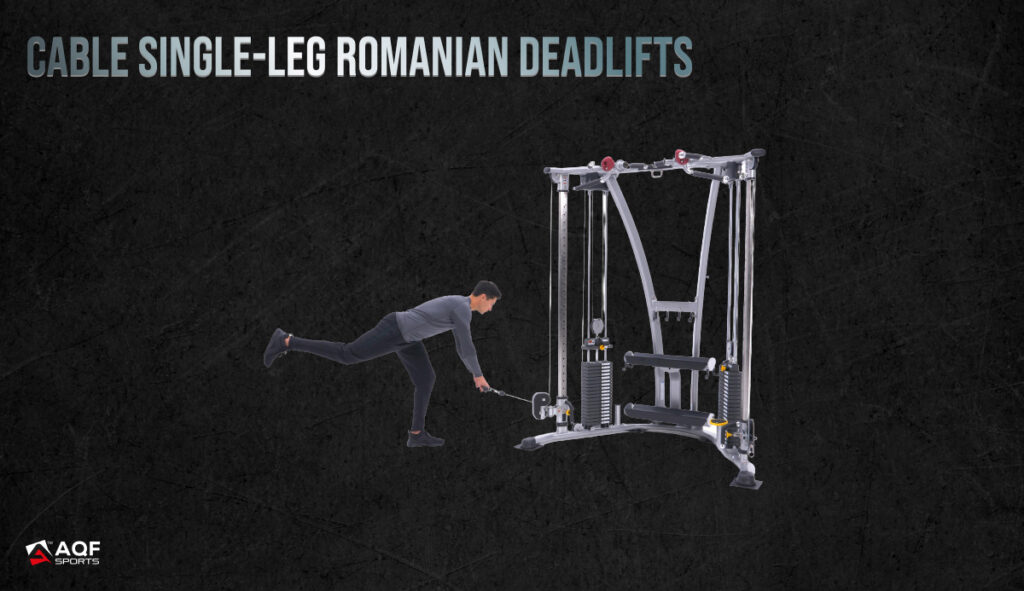
Cable Split Squats:
- Set the cable pulley at a low position and stand facing away from the machine.
- Position one foot forward and the other foot elevated on a bench or platform.
- Hold the cable handles for balance.
- Bend the front knee and Lower your body
- Keep your back knee close to the floor.
- Push through your front heel to return to the starting position.
- Switch legs and complete the desired number of repetitions
Primary muscles: Quadriceps, Glutes
Secondary muscles: Hamstrings, Calves
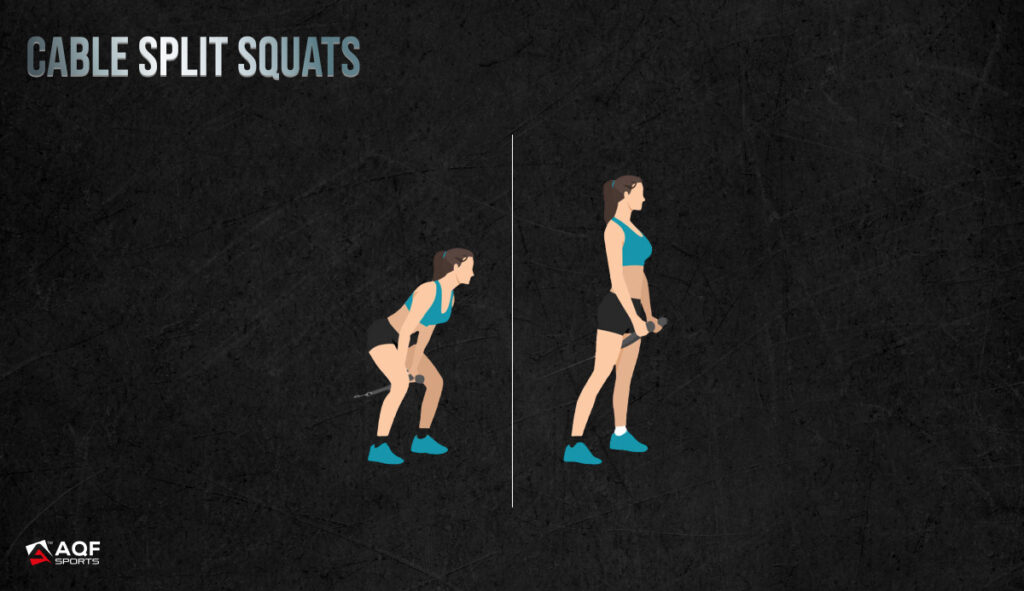
Cable Squat Walkouts:
- Set the cable pulley at a low position and stand facing away from the machine.
- Hold the cable handle and bring your chest closer to the machine
- Walk forward, away from the machine, and increase tension on the cable.
- Take small steps, keeping your hips low and your back straight.
- Walk as far as you can, then reverse to return to the starting position.
Primary muscles: Quadriceps, Glutes
Secondary muscles: Hamstrings, Calves
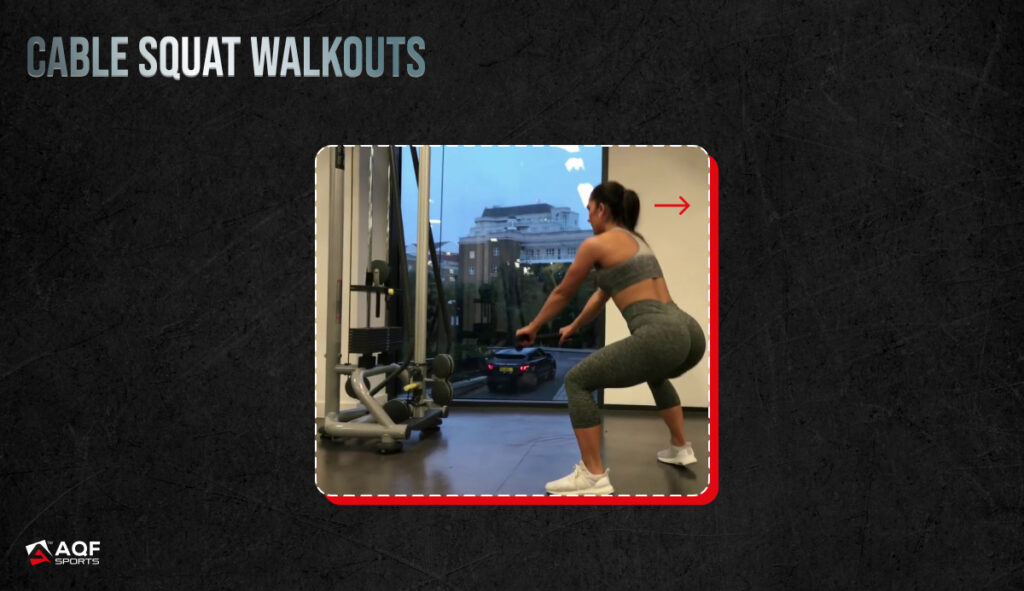
Let’s Try to Understand Your Leg Anatomy
Your leg comprises upon several primary muscles (directly activated during cable leg exercises) and secondary muscles (activated as a result of movement in primary muscles).
Quadriceps:
Quadriceps are a group of four muscles (rectus femoris, vastus lateralis, vastus medialis, and vastus intermedius) located on the front of your thigh. The muscles work together to extend (extension) and bend the knee joint (flexion).
Quads are primarily responsible for straightening legs during squats, lunges, and leg extensions. When you push into the ground through your heels and rise from a squat or lunge position, you are essentially engaging your Quads.
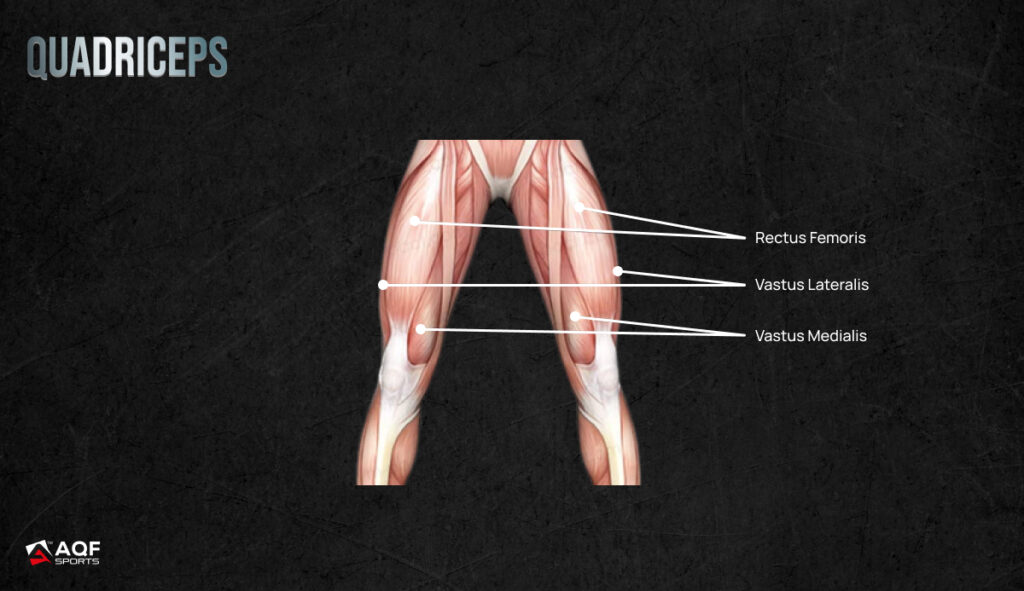
Hamstrings:
Hamstrings are a group of three muscles (biceps femoris, semitendinosus, and semimembranosus) located on the back of your thigh. The muscles work collectively to flex the knee joint and extend the hip joint.
Deadlifts and hamstring curls activate your hamstrings. Hamstrings provide the power and flexibility needed to lower your hip when moving your body down.
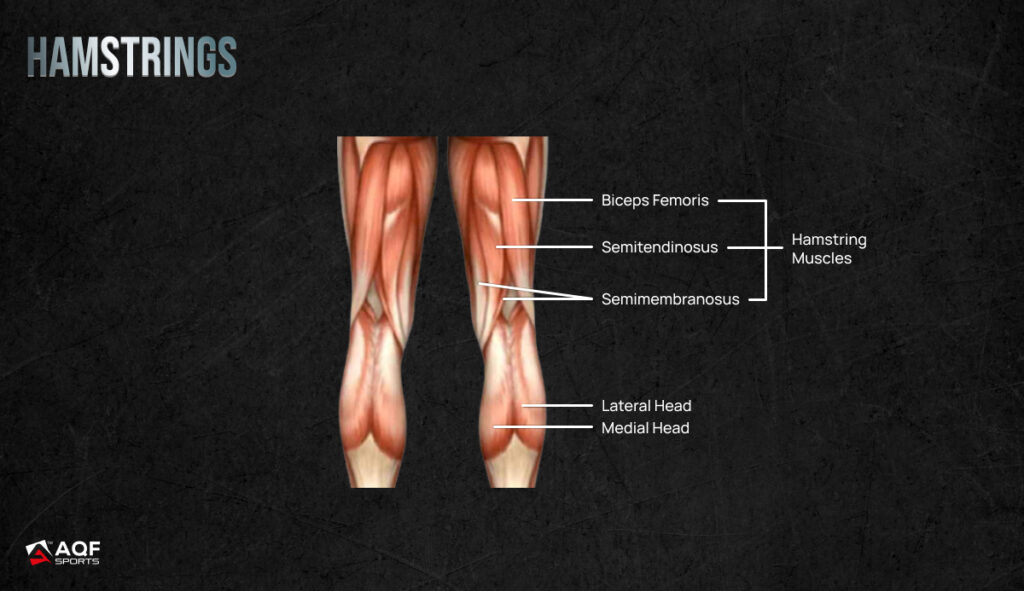
Glutes:
The gluteal muscles are the gluteus maximus, gluteus medius, and gluteus minimus. These muscles form your buttocks. The gluteus maximus is the largest muscle in the body. It’s responsible for hip extension during squats, lunges, and hip thrusts.
When you extend your hips during a squat rise or thrust your hips forward during cable leg exercises, the glutes contract to generate power and stabilize the pelvis. So if you want to get that jiggly butt, keep in mind that you will need to train your Gluteus muscles.
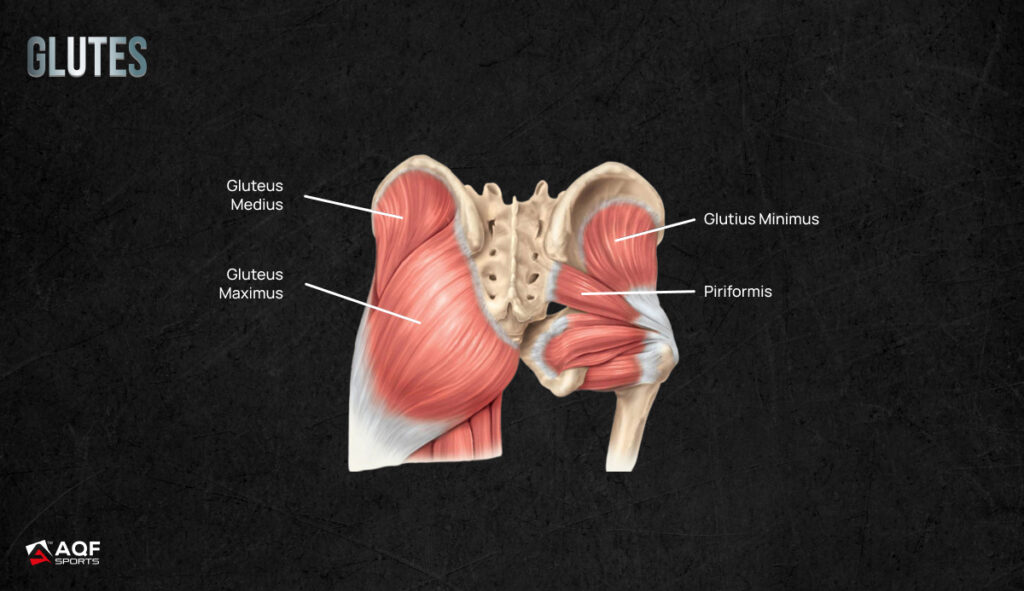
Calves:
The calves consist of two primary muscles: the gastrocnemius (larger calf muscle) and the soleus (which lies under the gastrocnemius).
These muscles are engaged in plantar flexion (heel movements) for pointing the toes downward. Calves are engaged to propel the heels upward during calf raises and cable leg heel exercises.

In Short:
- Squats activate the quadriceps, hamstrings muscles which work together to lower your body and push it back up.
- Deadlifts activate the hamstrings and glutes and these muscles extend the hips while your lower back stabilizes your posture.
- Calf raises primarily target the gastrocnemius and soleus muscles to increase calf size and strength
- Cable Machine Exercises work all these muscles – your quadriceps, glutes, hamstrings, and calves. So, they are a complete lower body workout.
How to Progress in Your Cable Machine Workout?
Now, let’s talk about another very important aspect of lower body strength training – Progressive overload. Without increasing your workout resistance, you can not really expect to get consistent results.
You will likely hit plateaus and give up eventually if you do not make your workout more challenging.
Suggested Read: How to Get Tougher With 9 Effective Strength Training Exercises
Here are a few expert trainer tips to increase your leg workout intensity:
Increase Weights:
Expert trainers recommend gradually increasing the workout resistance by increasing weights. Start with a weight which lets you adjust your form and control. Aim for reaching muscle fatigue within the desired rep range.
Once you comfortably complete the target number of reps and sets using the same weight, it’s time to level up. Remember the rule “No Pain, No Gain”
Gradually increase 5-10% of previous weight to stimulate further muscle growth and strength gains.
Suggested Read: How To Lift Heavier Weights: Mistakes To Avoid & Tips To Follow
Expert Trainers Say:
“Progressive overload is key for muscle adaptation. Gradually increasing cable machine resistance challenges your muscles and forces them to adapt and grow stronger.”
Adjust Reps and Sets:
Start with moderate reps and sets i.e. 8-12 reps and 2-3 sets per exercise. When you gain strength and endurance, increase either the number of reps or number of sets to challenge your muscles. For example, you can increase the reps to 12-15 or add an additional set to push your limits.
Expert Trainers Say:
“Increasing the number of reps or sets creates additional stimulus for muscle growth and improves muscular endurance. Allow your muscles to adapt to increased workload over time.”
Implement Pauses and 1 ½ Reps:
Increase time under tension for your muscles and pauses and 1 ½ reps in your exercises.
Here is how you can implement Pauses or 1 ½ reps:
- Complete one full rep
- Go back halfway in the exercises
- Return to the toughest part of the exercise
- Finish the rep.
This technique is particularly effective for squat and lunges and can be added to your routine for an advanced challenge.
Tempo and Drop Sets:
Observe your time to complete a rep and add intensity to your cable machine exercises. Add more seconds to the eccentric (lowering) portion – thereby increasing time to lower body. You can also hold the position for a few more seconds before ending the set.
Add drop sets by reducing the weight but doing reps without rest. This will exhaust your muscles faster and boost muscle strength and development
Modify your Range of Leg Motion:
Modify your range of motion for exercises like reverse lunges, forward lunges, and split squats. All you have to do is Elevate your front or rear foot on a step or weight bench. This modification increases your range of motion, challenges your muscles and improves muscles growth and agility.
Get Your Leg Up with Cable Machine Exercises!
Make your leg day more challenging and rewarding with 15 days lower body workout challenge focusing on cable leg exercises. Cable leg workout activates all primary muscle groups and secondary muscle groups in your leg to stimulate muscle growth, build muscle strength and endurance, and gives you a more athletic and agile appearance. The key to progressive gains is progressive overloading. So, the next time you visit your neighborhood gym or home gym, don’t forget to train your legs. Remember, skipping leg day did good to none!
Related Reads:
- Strength Training Program for Men and Women
- 11 Weighted Squats Variations You Need
- Rest Pause Sets Training: Benefits, Variations and Techniques
References:
[1] Dorgo, S., Edupuganti, P., Smith, D. R., & Ortiz, M. (2012). Comparison of lower body specific resistance training on the hamstring to quadriceps strength ratios in men and women. Research quarterly for exercise and sport, 83(2), 143-151.
[2] Jacobs, P. L., & Nash, M. S. (2004). Exercise recommendations for individuals with spinal cord injury. Sports medicine, 34, 727-751.
[3] Earl, J. E. (2005). Gluteus medius activity during 3 variations of isometric single-leg stance. Journal of Sport Rehabilitation, 14(1), 1-11.
[4] Kunugi, S., Masunari, A., Yoshida, N., & Miyakawa, S. (2017). Postural stability and lower leg muscle activity during a diagonal single-leg landing differs in male collegiate soccer players with and without functional ankle instability. The Journal of Physical Fitness and Sports Medicine, 6(4), 257-265.






